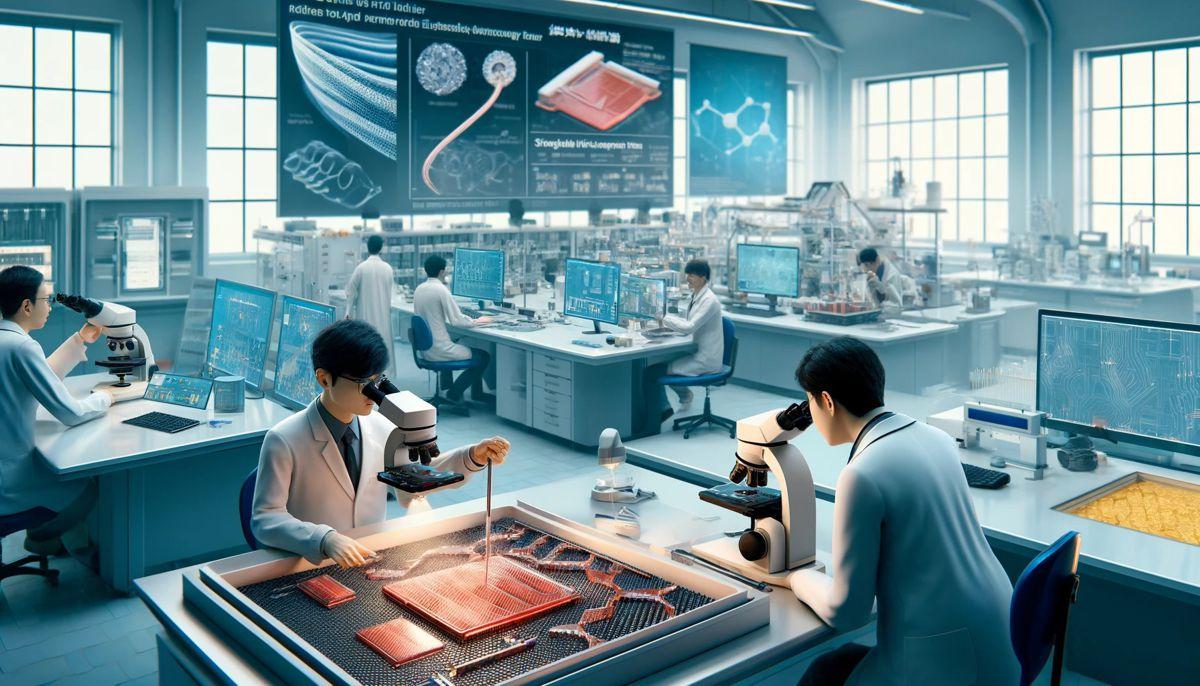R.E.News future Technology-The Development of Elastic Energy Storage Devices
 16/05/24-FR-English-NL-footer
16/05/24-FR-English-NL-footer
Le développement de dispositifs de stockage d’énergie élastiques
 Image- National Research Council of Science and Technology
Image- National Research Council of Science and Technology
L'équipe de recherche conjointe, dirigée par le Dr Chanwoo Yang et le chercheur Seong Ju Park de l'Institut coréen de technologie industrielle (KITECH), ainsi que par le professeur Jin Kon Kim et le Dr Keon-Woo Kim de POSTECH, a développé avec succès un système de stockage d'énergie compact. dispositif avec une excellente élasticité.
Cette recherche a été publiée dans la revue de renommée mondiale dans le domaine de l’ingénierie électronique, « npj Flexible Electronics ».
Au-delà des appareils pliables et enroulables, l’ère des appareils informatiques extensibles arrive. Pour ces dispositifs, le développement de petits dispositifs de stockage d’énergie élastiques est essentiel. À cet égard, les micro supercondensateurs (MSC) attirent l’attention en tant que très petits volumes capables d’alimenter de tels appareils électroniques. Cependant, les métaux solides couramment utilisés comme collecteurs de courant, tels que l'or (Au), ont une capacité d'étirement intrinsèquement limitée, limitant considérablement leur potentiel de déformation.
Dans cette étude, l’équipe a sélectionné le métal liquide gallium-indium (EGaIn) comme collecteur de courant MSC. EGaIn a une conductivité très élevée et, en raison de sa nature liquide, est facilement déformable. Cependant, sa mise en forme a posé des défis techniques importants. Pour surmonter ce problème, l’équipe a conçu une méthode de modélisation d’EGaIn à l’aide d’un laser. Ils ont utilisé avec succès l’énergie intense du laser pour modeler EGaIn de manière simple et précise, l’appliquant efficacement comme collecteur de courant du MSC.
Grâce à cette technologie, l’équipe de recherche a pu créer un MSC pouvant être étiré et rétréci plus de 1 000 fois sans aucune perte de performances de stockage d’énergie. De plus, cet appareil a démontré une capacité d’alimentation en énergie stable même lorsqu’il est tordu, plié ou froissé.
Le Dr Yang a déclaré : « La technologie laser permet un travail précis tout en accélérant le processus », et a exprimé son espoir que « cette recherche sera utile dans divers domaines industriels et contribuera au développement et à la commercialisation de dispositifs de stockage d'énergie élastiques ».
Cette recherche a été soutenue par le développement de la technologie des processus racines pour la flexibilité de la production au KITECT et le projet de recherche créative du ministère des Sciences et des TIC et publiée dans les articles de npj Flexible Electronics (IF : 14,6 & JCR : 2,0 %), mars 2024. .
KITECH, fondé en 1989 en tant que filiale du ministère du Commerce et de l'Industrie, est devenu l'un des principaux instituts de recherche appliquée en Corée. KITECH relève les défis de transformation numérique auxquels sont confrontées les industries locales, tant en interne qu'en externe, en prenant la tête du soutien à l'innovation manufacturière coréenne à l'échelle mondiale.
NJC.© Info National Research Council of Science and Technology
------------------------------------------------------------------------------------------------------------------
 16/05/24-English
16/05/24-English
The Development of Elastic Energy Storage Devices
 Image- National Research Council of Science and Technology
Image- National Research Council of Science and Technology
The joint research team, led by Dr. Chanwoo Yang and Researcher Seong Ju Park from Korea Institute of Industrial Technology(KITECH), along with Prof. Jin Kon Kim and Dr. Keon-Woo Kim from POSTECH, has successfully developed a compact energy storage device with excellent elasticity.
This research was published in the world-renowned journal in the field of electronic engineering, ‘npj Flexible Electronics’.
Beyond foldable and rollable devices, the era of stretchable IT devices is arriving. For these devices, the development of small, elastic energy storage devices is essential. In this respect, micro supercapacitors (MSCs) are gaining attention as very small volumes that can power such electronic devices. However, the solid metals commonly used as current collectors, such as gold (Au), have inherently limited stretch ability, significantly restricting their potential for deformation.
In this study, the team selected gallium-indium liquid metal (EGaIn) as the MSC current collector. EGaIn has very high conductivity and, due to its liquid nature, is easily deformable. However, shaping it has posed significant technical challenges. To overcome this, the team devised a method of patterning EGaIn using a laser. They successfully used the intense energy of the laser to pattern EGaIn simply and precisely, applying it effectively as the MSC’s current collector.
Based on this technology, the research team was able to create an MSC that could be stretched and shrunk over 1,000 times without any loss of energy storage performance. Furthermore, this device demonstrated stable energy supply capability even when twisted, folded, or crumpled.
Dr. Yang stated: “Laser technology allows for precise work while also speeding up the process,” and expressed his hope that “this research will be useful in various industrial fields and contribute to the development and commercialization of elastic energy storage devices.”
This research was supported by the Development of Root Process Technology for Production Flexibility at KITECT and the Creative Research Project of the Ministry of Science and ICT and published in the articles of npj Flexible Electronics (IF: 14.6 & JCR: 2.0%), Mar 2024.
KITECH, founded in 1989 as an affiliate of the Ministry of Commerce and Industry, has emerged as a premier comprehensive applied research institute in Korea. KITECH is addressing the digital transformation challenges confronting local industries, both internally and externally, by leading the charge in supporting Korean manufacturing innovation globally.
NJC.© Info National Research Council of Science and Technology
------------------------------------------------------------------------------------------------------------------
 16/05/24-NL
16/05/24-NL
De ontwikkeling van elastische energieopslagapparaten
 Image- National Research Council of Science and Technology
Image- National Research Council of Science and Technology
Het gezamenlijke onderzoeksteam, geleid door dr. Chanwoo Yang en onderzoeker Seong Ju Park van het Korea Institute of Industrial Technology (KITECH), samen met prof. Jin Kon Kim en dr. Keon-Woo Kim van POSTECH, heeft met succes een compacte energieopslag ontwikkeld apparaat met uitstekende elasticiteit.
Dit onderzoek is gepubliceerd in het wereldberoemde tijdschrift op het gebied van elektronica, ‘npj Flexible Electronics’.
Naast opvouwbare en oprolbare apparaten breekt het tijdperk aan van rekbare IT-apparaten. Voor deze apparaten is de ontwikkeling van kleine, elastische energieopslagapparaten essentieel. In dit opzicht krijgen micro-supercondensatoren (MSC's) steeds meer aandacht als zeer kleine volumes die dergelijke elektronische apparaten van stroom kunnen voorzien. De vaste metalen die gewoonlijk als stroomcollectoren worden gebruikt, zoals goud (Au), hebben echter inherent een beperkt rekvermogen, waardoor hun potentieel voor vervorming aanzienlijk wordt beperkt.
In deze studie selecteerde het team gallium-indium vloeibaar metaal (EGaIn) als de MSC-stroomcollector. EGaIn heeft een zeer hoge geleidbaarheid en is door zijn vloeibare karakter gemakkelijk vervormbaar. Het vormgeven ervan heeft echter aanzienlijke technische uitdagingen met zich meegebracht. Om dit te ondervangen, bedacht het team een methode om EGaIn-patronen te vormen met behulp van een laser. Ze hebben met succes de intense energie van de laser gebruikt om EGaIn eenvoudig en nauwkeurig te modelleren en deze effectief toe te passen als de stroomcollector van de MSC.
Op basis van deze technologie kon het onderzoeksteam een MSC creëren die meer dan 1000 keer kon worden uitgerekt en gekrompen zonder enig verlies aan energieopslagprestaties. Bovendien vertoonde dit apparaat een stabiel energietoevoervermogen, zelfs wanneer het gedraaid, gevouwen of verkreukeld was.
Dr. Yang verklaarde: “Lasertechnologie maakt nauwkeurig werken mogelijk en versnelt tegelijkertijd het proces”, en sprak de hoop uit dat “dit onderzoek nuttig zal zijn op verschillende industriële gebieden en zal bijdragen aan de ontwikkeling en commercialisering van apparaten voor elastische energieopslag.”
Dit onderzoek werd ondersteund door de ontwikkeling van rootprocestechnologie voor productieflexibiliteit bij KITECT en het Creative Research Project van het ministerie van Wetenschap en ICT en gepubliceerd in de artikelen van npj Flexible Electronics (IF: 14.6 & JCR: 2.0%), maart 2024 .
KITECH, opgericht in 1989 als onderdeel van het Ministerie van Handel en Industrie, heeft zich ontwikkeld tot een vooraanstaand alomvattend toegepast onderzoeksinstituut in Korea. KITECH pakt de uitdagingen op het gebied van digitale transformatie aan waarmee lokale industrieën worden geconfronteerd, zowel intern als extern, door het voortouw te nemen bij het wereldwijd ondersteunen van Koreaanse productie-innovatie.
NJC.© Info National Research Council of Science and Technology
----------------------------------------------------------------------------------------------------------------
Date de dernière mise à jour : 14/05/2024
















